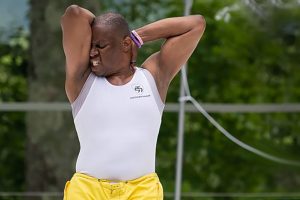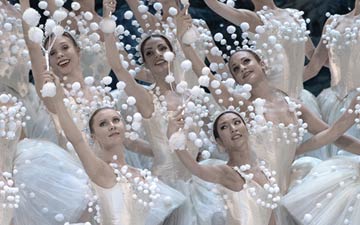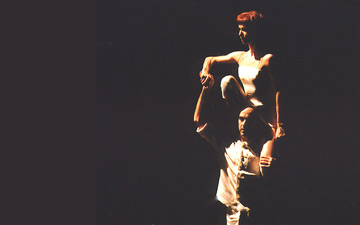
TanzOlymp 2014
Berlin, University of the Arts
18-21 February 2014
www.tanzolymp.com
www.udk-berlin.de
While the countries of the world have been battling for Olympic medals by the shores of the Black Sea in Sochi, another friendly confrontation was going on on a stage in Berlin. For four days, over 1,000 young dancers from 35 countries have been competing – with smiles – in the eleventh TanzOlymp, a dance competition for students from the ages of 8 to 21. Under the banner ‘Dance is a world language’ they came literally from across the globe: from Europe, Scandinavia, Asia, North and South America, to perform classical ballet, folk, modern, jazz, pop and tap dancing. And what a vast collection of talent, styles and costumes was on show. The enthusiasm never waned even though the days were long, from the 9:30 morning class and starting time of 11am up to 10 at night. The mere logistics of getting the dancers-sometime a group of up to sixteen – from hotel, to rehearsal, to costuming and finally being on stage at the right time, was skilfully handled by the organizer of the event for the past eleven years, Oleksi Bessmertni, and his small cohort of workers. Bessmertni, born in Odessa, was a dancer himself at the Budapest State Opera, Baden State Theatre and the Deutsche Staatsoper Ballet. He started this competition in 2004 with 380 participants, and it has grown and grown over the years with over 90 countries participating. In addition to their time on stage, the young dancers are given the opportunity to take workshops, master classes from famous names in the dance world and to have guided sightseeing tours around Berlin. And there’s the opportunity to meet with each other, form new friendships and compare standards and styles. There was certainly a variety of entertaining works on show and some of the performances were just stunning.
As expected, it was the youngest group that were the most enchanting to watch. Aged from 8 to 12, (though many looked much younger), they exuded confidence, concentration and a complete joy in dancing. Their stage presence and precision were amazing and not one child could be faulted. There were few soloists in this age group, though a couple of little girls did catch my eye. Tiny Karina Tuskumbaeva with a plait that touched the ground, did a gymnastic rhythmical piece called Golden Bee, twirling the plait around her head or removing it and playing with it, and her tidy work won her a second prize. And there was the flamingo – another pint-sized little thing (name unknown as there were no official programmes). Wearing a mini pink tutu around her waist over a pink leotard, she held her hands effectively above her head making a long neck and beak and then proceeded to strut, balance on one leg and turn countless somersaults in time with the music. She showed such a presence on such a big stage.
The older classical contributions (age groups 13-15, 16-18, 19-21) showed off the good training on offer around the world, though, like many competitions these days, it is the Asians who are racing ahead with style, precision and technique. Good news for the audience was that there weren’t countless Don Qs or Odettes to watch. The participants chose short solos from a large selection of ballets that showed off their talents. And how could they not dance well when they were attired in such splendid brand new costumes? The girls had beautiful tutus in countless pastel shades, all sequin decorated, with light-catching tiaras, while the boys wore pristine tights and fitted jackets. In their solos and duets it was soon evident who thought points were won with high kicks, tricks and speedy turns, or who couldn’t turn well or spot. However, there were plenty of others who showed natural artistry and successfully presented themselves with an understanding of their roles. A Junoesque ballerina, Victoria Vassos from Berlin, performed an elegant and sensitive Dying Swan for which she received a 1st prize. The Korean dancers, Gohen Lee and Jin Sol Eum offered a crisp and technically exciting The Flames of Paris which also won them a 1st. For the first time, a Panamanian girl entered the competition – Ana Lorena Boyd – and returned home with a 3rd place medal for her solo in Paquita, which she performed with grace and accuracy.

There were 85 entries in the modern section and of these, the Koreans danced 56, demonstrating intelligence and strong technical ability. (Altogether there were 592 dance entries –-give or take a few who didn’t turn up – performed during the three days.) On the whole the individual offerings were pleasing and interestingly choreographed, but with some, there was over-emphasis on wild abandon, fits of madness, fear or terror, complemented with ‘compulsory’ long loose hair whipping around and obscuring faces. Exceptions were Yael Fisher from Berlin who was stylish yet strong in making images with his arms and body, Nathan Alves who, bare chested and wearing a leather skirt, danced Solento with strong technique, and the athletic Jeong Hyan Ha who smiled all through his Everything Must Change routine.
Ensemble work was seen in the pop and folk dancing groups and was colourful and fun. The pop group had everything from Bollywood to Falling in love with a Cossack as themes, and the choreography was pleasing and inventive. It was refreshing to see the Russians perform ‘narratives’ that flashed back to yesteryear – hen-pecked peasant husbands, sailor girls, miniature airmen in helmets and goggles (who cleverly transformed their mini-partners into planes), and scenes where children played freely and joyously in the fields of the collective farms. There was a ‘Railway Children’ piece by a group from Magnitogorsk, Russia, in which a bunch of young girls in summer frocks and pigtails waved to a passing train then chased each other playfully until the next train came. The same group also danced Jolly Boom, a look at today’s generation. Wearing big headphones, kneepads and cut-offs, it was a fast-action piece with rolls, leaps, continuous movement, and the audience had as much fun jiggling in their seats as the dancers. In both pieces there was one young girl – the smallest and about 14 years old – who grabbed my attention from the moment she came on stage until she finished. (No name again, sadly). She resembled Natalia Osipova both facially and in her complete absorption and sheer delight in dancing, moving with purpose and being carried away with the music. We also watched Cowboys and Indians, a glittering golden gathering of Egyptian mummies with wiggling hips, Eskimos, a West Side Story style confrontation called Jazz Cocktail, which was fast and furious, three contented little pigs from a “Happy Farm’ and a sassy and sunny Bossacucanova from Valentina Kozlova’s students from New York which got the audience’s feet tapping. It was heart warming to see so many enthusiastic boys of differing sizes and ages in this pop division, and also the folk dancing. This section presented the vitality and precision of different national dances, all passionately performed. A group from Brazil were graceful and lyrical in their Chinese traditional dances – one with floor-length sleeves, the other with large shocking pink ostrich fans; there was a delightful nifty Finnish Quadrille by dancers from Moscow in the youngest group; three Georgian girls danced commanding yet elegant men’s dances on pointe, while in the younger group, two small boys and one girl performed Adjaruli with exciting speedy footwork, dancing on the knuckles of their feet in soft leather boots. They were very professional and their efforts won them 1st prize.
If one is to be critical over anything in the four-day event it is to say that, while the children have been taught to dance on stage, they have not been told the etiquette and manners needed, especially when being presented with prizes. Only a handful of the young dancers acknowledged the jury and audience when they came on stage, while some looked grumpy and uncomfortable – and were dressed to go sightseeing! Also there was an obvious need to teach some of the girls how to walk on and around the stage graciously.
The jury, under the chairmanship of Vladimir Vasiliev, consisted of 19 members, all directors of respected ballet schools from 15 countries. They included Nina Ananiashvili, Chan Hon Goh, Ted Brandsen, Septime Webre, Caroline Llorca, Francesca Zumbo, Valentina Kozlova and Samira Saidi. They had the hard task of adjudicating the vast selection of styles and talents in the four age groups and they shared the duties since the days were long. Several of them gave scholarships to candidates who had impressed.
After the lengthy prize-giving, forty numbers were performed in a gala concert. Thanks to their enthusiasm, vitality, joy and flair, these young dancers, gave a different audience a taste of what TanzOlymp is all about. Given the evidence at this year’s competition, dance looks very much alive and sparkling in all its facets around the world.

















You must be logged in to post a comment.